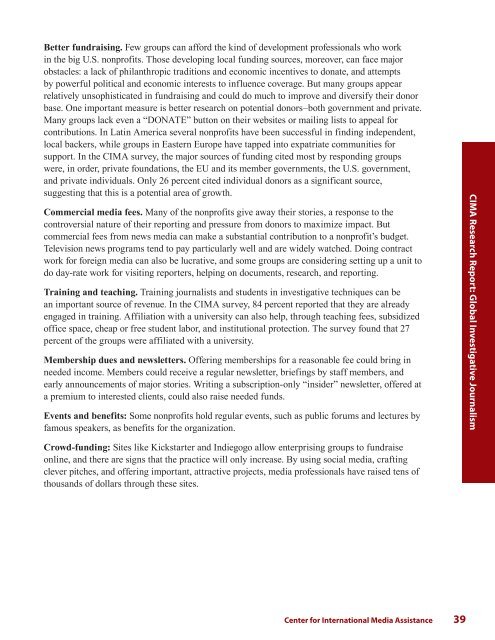CIMA-Investigative Journalism - Dave Kaplan
CIMA-Investigative Journalism - Dave Kaplan
CIMA-Investigative Journalism - Dave Kaplan
You also want an ePaper? Increase the reach of your titles
YUMPU automatically turns print PDFs into web optimized ePapers that Google loves.
Better fundraising. Few groups can afford the kind of development professionals who work<br />
in the big U.S. nonprofits. Those developing local funding sources, moreover, can face major<br />
obstacles: a lack of philanthropic traditions and economic incentives to donate, and attempts<br />
by powerful political and economic interests to influence coverage. But many groups appear<br />
relatively unsophisticated in fundraising and could do much to improve and diversify their donor<br />
base. One important measure is better research on potential donors–both government and private.<br />
Many groups lack even a “DONATE” button on their websites or mailing lists to appeal for<br />
contributions. In Latin America several nonprofits have been successful in finding independent,<br />
local backers, while groups in Eastern Europe have tapped into expatriate communities for<br />
support. In the <strong>CIMA</strong> survey, the major sources of funding cited most by responding groups<br />
were, in order, private foundations, the EU and its member governments, the U.S. government,<br />
and private individuals. Only 26 percent cited individual donors as a significant source,<br />
suggesting that this is a potential area of growth.<br />
Commercial media fees. Many of the nonprofits give away their stories, a response to the<br />
controversial nature of their reporting and pressure from donors to maximize impact. But<br />
commercial fees from news media can make a substantial contribution to a nonprofit’s budget.<br />
Television news programs tend to pay particularly well and are widely watched. Doing contract<br />
work for foreign media can also be lucrative, and some groups are considering setting up a unit to<br />
do day-rate work for visiting reporters, helping on documents, research, and reporting.<br />
Training and teaching. Training journalists and students in investigative techniques can be<br />
an important source of revenue. In the <strong>CIMA</strong> survey, 84 percent reported that they are already<br />
engaged in training. Affiliation with a university can also help, through teaching fees, subsidized<br />
office space, cheap or free student labor, and institutional protection. The survey found that 27<br />
percent of the groups were affiliated with a university.<br />
Membership dues and newsletters. Offering memberships for a reasonable fee could bring in<br />
needed income. Members could receive a regular newsletter, briefings by staff members, and<br />
early announcements of major stories. Writing a subscription-only “insider” newsletter, offered at<br />
a premium to interested clients, could also raise needed funds.<br />
Events and benefits: Some nonprofits hold regular events, such as public forums and lectures by<br />
famous speakers, as benefits for the organization.<br />
Crowd-funding: Sites like Kickstarter and Indiegogo allow enterprising groups to fundraise<br />
online, and there are signs that the practice will only increase. By using social media, crafting<br />
clever pitches, and offering important, attractive projects, media professionals have raised tens of<br />
thousands of dollars through these sites.<br />
Center for International Media Assistance 39<br />
<strong>CIMA</strong> Research Report: Global <strong>Investigative</strong> <strong>Journalism</strong>


